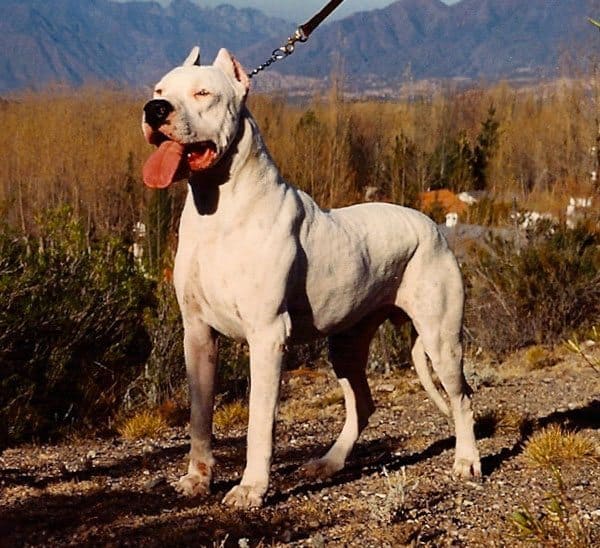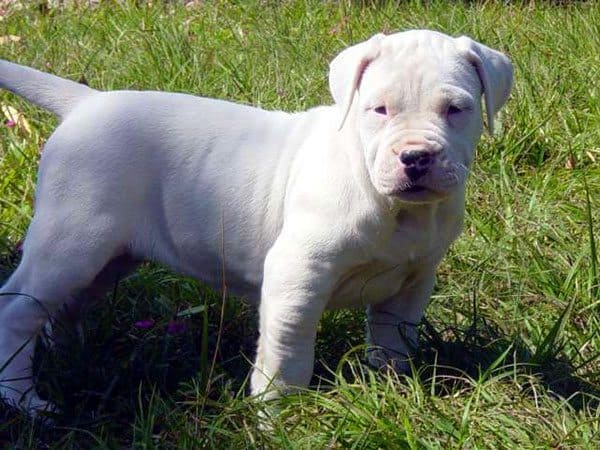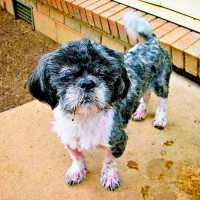
The Argentine Dogo is the result of a breeding program that was begun in 1925. Antonio Nores Martinez was not quite 18 years of age when he told his younger brother (by one year), Agustin, of his desire to create a new breed of hunting dog. A breed of dog that started with the Fighting Dog of Cordoba, an extraordinarily courageous breed of dog that was at that time useless for pack hunting due to its hostility towards other dogs, people, and animals. Due to the interference of man the Fighting Dog of Cordoba was destined for extinction. Antonio Nores Martinez knew he wanted to use the Fighting Dog of Cordoba’s courage as a beginning foundation. He wanted to eliminate the fighting urge and replace it with a hunting instinct that was equally strong. The two brothers spent all of their pocket money buying food for their dogs. They were able to enlist the help of their family and friends who backed the brother’s endeavor with a confidence that was remarkable. Antonio became a surgeon, and his medical knowledge helped to advance, improve and refine the breed that had become his life’s passion.
There were ten breeds of dog that were used to produce the Argentine Dogo. The foundation was the Fighting Dog of Cordoba, ten females were used to begin with. The Pointer was used to develop and sharpen the sense of smell that is required for the hunt. The Boxer added energy and gentleness to the line. The Great Dane contributed its size and height. The Bull Terrier added to the fearlessness of the progeny. The Bulldog contributed its chest build to the physiology of the new breed, and boldness of spirit and tenacity to its personality. The Irish Wolfhound was used not only for size, but for its hunting instinct as well. The powerful jaws of the Dogue de Bordeaux, as well as more strength and courage,were desired and this breed was incorporated into the breeding program. The Great Pyrenees contributed its white coat, which is weather resistant, and bulk, and the Spanish Mastiff was used to contribute even more power to an already powerful animal.
In 1956, Antonio Nores Martinez died at the hands of a robber while he was out on a hunt. He never got to see the fruitition of his life’s work. The younger brother, Agustin, worked to salvage his older brother’s dream of a new breed of dog. And he succeeded.
The Dogo Argentino was recognized in 1964 by the Cinologic Federation of Argentina. The Argentina Kennel Club, which is a member of the Federation Cynologique International (FCI), gave recognition to the breed in 1973. The Dogo Argentino Club of America was founded in 1985.
Dogos are known for being extremely loyal and affectionate with their families and crave attention from their owners. They are extremely tolerant of children due to low body sensitivity or high pain tolerance, a trait which stems from selective breeding as big game hunters. Like all dogs of any size or breed, they require obedience training and socialization; no dog should be left unattended with small children. They are protective of what they perceive as their territory and will guard it against any intruder. They get along with other dogs as long as they have been properly socialized, but will usually not tolerate another dog trying to assert dominance over them and might not coexist peacefully with another dominant breed of dog. They can develop an aggressive or dominant temperament if not socialized with other dogs at an early age, particularly with other dogs of the same sex. Dog aggression per se is absolutely not a desirable trait in the Dogo Argentino, as it is at odds with its intended purpose as a pack hunter. A single “pet” dogo without a working outlet for energy and drive may feel himself to be “king of the mountain” and carry himself accordingly, though the same dog may work perfectly cooperatively with other males while hunting.
Dogos are typically strong-tempered animals not suitable for the novice dog owner; they do best with an experienced handler. Dogos are recent comers to suburban life. Unlike many breeds classified as “working dogs”, dogos are not “historically” working dogs, but dogs currently and actively selected for working function and temperament. Pet owners interested in the Dogo Argentino would do well to remember that these are working animals with a serious need for exercise and outlet of hunting drive by way of activities such as tracking, trailing, or sport work.
Dogos Argentinos are accomplished big-game hunters, and are used today in a variety of ways from tracking, search and rescue, general police work including narcotics detection, military and family dogs. They are even occasionally used as guide dogs, or as service animals, though their primary work remains boar hunting. Due to their very great prey drive, physical capabilities and strong temperament, they are not dogs commonly suited to be suburban backyard pets, though they do make excellent companions for exceptionally capable and dedicated dog owners.
Due to pigment-related deafness, as in the dalmatian and the white bull terrier, the dogo commonly experiences an approximately 10% deafness rate overall with some dogos afflicted unilaterally (one deaf ear) and some dogs bilaterally (deaf in both ears). It is impossible to adequately diagnose deafness, particularly unilaterally-afflicted dogs, through behavioral testing. Due to the advancement of BAER technology and growing availability in the United States and around the world, veterinarians and dog breeders are now able to adequately identify congenital deafness at a very early age. This means that breeders are now are able to actively select against pigment-related congenital deafness in a way never possible before the advent of BAER technology. Studies show the incidence of deafness is drastically decreased when only breeding stock with bilaterally normal hearing is used. It is important for any prospective puppy-buyer to carefully question the breeder regarding potential genetic afflictions and health-screening practices. Reputable breeders in the United States will have BAER tested all breeding stock and all puppies prior to sale, though there are areas of Argentina and Europe where BAER testing is still not widely accessible. A conscientious puppy-buyer will proceed with caution when importing a puppy from a foreign country; novices should consider contacting the national breed parent club for assistance.
As with all large dogs, hip dysplasia is potential though highly uncommon in lines actively worked. With careful feeding and prudent exercise during the growth stage, and most of all purchasing a puppy from a reputable working kennel, concerns with CHD are uncommon in this breed.
The Dogo Argentino was bred specifically to avoid the dog aggression problems inherent in the Cordoban Fighting Dog when applied to hunting, specifically its lack of ability to hunt cooperatively in a pack. The creators of the breed took great care to prevent this undesirable trait from manifesting in the Dogo Argentino, as the breed was always intended to function as a cooperative pack hunter. In particular areas of the world where dog fighting as a bloodsport remains culturally acceptable, some people have bred them for this purpose. Dogos of these lines are extremely dog-aggressive and not suited for big game hunting, unlike the original Dogo Argentino. In the United Kingdom it is illegal to own Dogos Argentinos without specific exemption from a court per the Dangerous Dogs Act 1991. The Australian government has banned the importation of this dog. In neither country was there a population of dogos at the time the breed-specific laws were passed. The dog is also illegal in New Zealand and Norway. The breed has also been made illegal in England and several other european countrys.
Info From Malcolm Dupris and Wikipedia.


